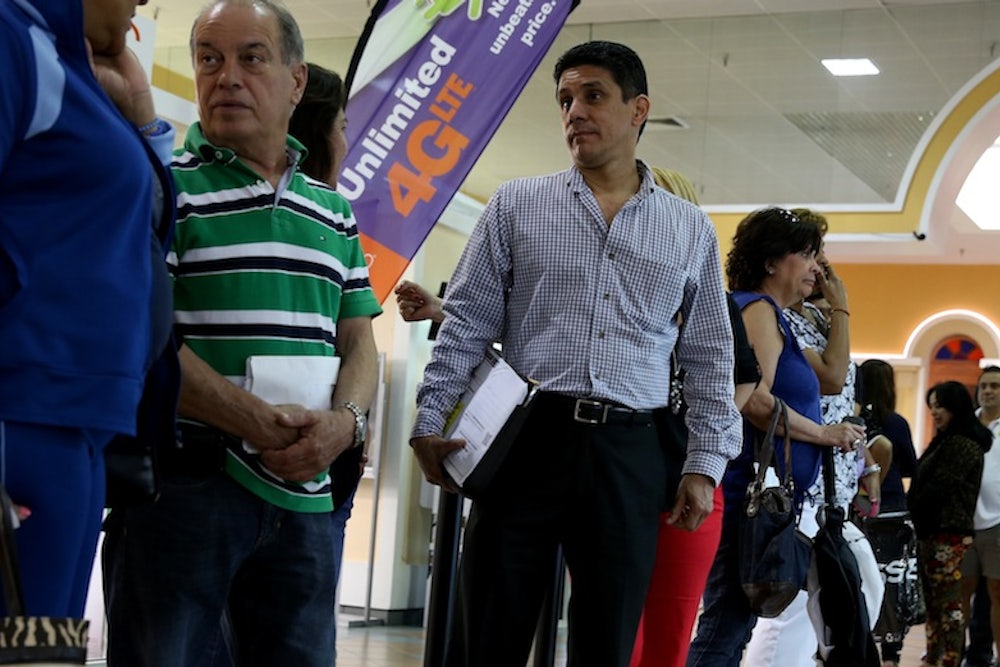Americans are signing up for the Affordable Care Act. And they appear to be doing so in really big numbers. As of the latest official update, last week, more than 6 million people had selected a private insurance plan through one of Obamacare’s new state marketplaces. But that was before a weekend of huge traffic to healthcare.gov and state-run websites, record call volume to telephone help centers, and queues outside outreach offices in California and even Texas. Charles Gaba, the Michigan-based analyst who runs the website ACASignups.net, now projects that 6.72 million people will sign up for private insurance by the time open enrollment ends.
Even accounting for the fact that some of these people won't actually pay their premiums, these figures would seem to undermine—or at least weaken—the argument that Obamacare is a catastrophic failure. Republicans and many of their allies obviously think otherwise. They are doing what they almost always do when data confounds their previously held beliefs. They are challenging the statistics—primarily, by suggesting that most of the people getting insurance already had coverage. Some, like Senator John Barrasso of Wyoming, say the administration is “cooking the books.” Others, like Senator Ted Cruz, say that the number of people without insurance is actually rising.
Sorry, but that’s nonsense. Conservatives making these arguments typically cite the same evidence that Cruz did in his interview: Surveys by McKinsey and Company suggesting that most of the people buying insurance on their own already had coverage. In February, McKinsey said only 14 percent of people buying coverage had no insurance previously; in March, McKinsey said the proportion had increased, but only to 27 percent. That certainly sounds disappointing.
But McKinsey’s survey included everybody buying individual coverage—in other words, people buying through the new marketplaces and people buying directly from insurers. And nobody would expect many of the latter to be among the previously uninsured. Instead, it’s mostly people who had coverage that carriers canceled, because the old policies didn’t comply with Obamacare regulations or because the old policies simply weren’t profitable anymore. News organizations like Politifact have pointed this out. Analysts like Gaba have pointed this out. Even McKinsey itself has pointed this out. That hasn’t stopped conservatives from citing the figures.
A better way to measure progress is to look at numbers from a handful of states that are collecting this kind of data and have reported it. Last week, New York officials told CNBC that 59 percent of people getting insurance through the state marketplace had no coverage before. The numbers were even higher in Kentucky, where officials told the network that 75 percent of people selecting plans had been uninsured before.
And according to Seattle Times columnist Danny Westneat, officials in Washington state who have studied their enrollment data believe that the overall effect of Obamacare has been to reduce the ranks of the uninsured by about 25 percent. To give you a sense of scale, the Congressional Budget Office has predicted that the Affordable Care Act will in 2014 decrease the number of uninsured nationally from about 57 million to about 44 million—a reduction of about 23 percent. So if those Washington officials are right, their state is actually outperforming expectations by a little bit.
Of course, in places like Georgia and Texas, where officials have tried to undermine the law and refused to expand their Medicaid programs, far fewer people will get coverage. And Washington officials could be wrong about what's happening in their state. It’s difficult to get reliable data on insurance status, in part because uninsurance frequently isn’t a permanent condition. Particularly among lower-income and part-time workers, somebody might spend a few months with coverage, a few months without coverage, and then repeat the cycle all over again. Surveys rarely pick up such distinctions.
It's also hard to extrapolate from statistics like raw signup figures, as Larry Levitt of the Kaiser Family Foundation explains:
You have to account for all the pieces of the puzzle: People buying their own insurance in the exchanges as well as directly from insurance companies. The increase in Medicaid enrollment due to expanded eligibility and outreach to people who were already eligible but not enrolled. Young adults now able to stay on their parents’ plans up until age 26. And any change in employer coverage, which could be up or down. It's going to take a while to know all of that.
It will—and that's why everybody should be cautious about making firm prounouncements about how the Affordable Care Act is doing. But right now it's not the Administration making the most preposterously definitive claims about the law's success or failure. It's Cruz, Barrasso, and all the other hard-core Obamacare opponents on the right.
Update: According to Noam Levey of the Los Angeles Times, unpublished research from the Rand Corporation suggests that the uninsurance rate among working-age adults has fallen from 20.9 percent in the fall to 16.6 percent now. That's roughly consistent with previously published survey findings from Gallup. Again, it's hard to know how accurate these surveys are. But they certainly suggest the law is succeeding in reducing the number of people without health coverage. The question is by how much.
